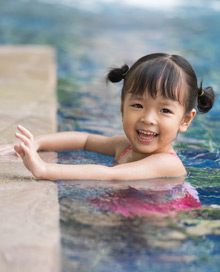Childhood Safety Topics
Safety Tips to Prevent Water-Related Injuries
 Nothing feels better on a hot day than splashing in cool water. Unfortunately, drowning is a top ten cause of death for kids up to age 14. Drowning happens fast (it can take less than 2 minutes) and even kids who know how to swim are at risk, so it is important for caregivers to know key water safety rules:
Nothing feels better on a hot day than splashing in cool water. Unfortunately, drowning is a top ten cause of death for kids up to age 14. Drowning happens fast (it can take less than 2 minutes) and even kids who know how to swim are at risk, so it is important for caregivers to know key water safety rules:
- Supervise children in the water, even if a lifeguard is present. Let babysitters know that supervision means constant visual contact, not just an occasional glance.
- Never leave your child unattended near water and do not trust a child’s life to another child.
- Learn to swim and enroll your child in swim lessons.
- Take a first aid or CPR course so you know what to do in an emergency.
- Keep a cell phone or cordless phone nearby when watching kids in the pool so you can call for help quickly.
- Kids and adults should always swim with a buddy.
- Young children and inexperienced swimmers should wear a Coast Guard approved life jacket around water. Inner tubes and water wings do not prevent drowning.
- If you have a pool, secure it with appropriate barriers—fencing should be at least 4 feet high and gates should be self closing and self latching.
- Young children can drown even in wading pools. Empty pools completely when not in use and supervise children when pools are filled.
- Teach kids to follow pool rules, like not running, not pushing other kids into the pool, and only diving in areas marked for diving.
- Teach kids to follow beach rules, such as only swimming when a lifeguard is on duty and swimming in designated areas.


